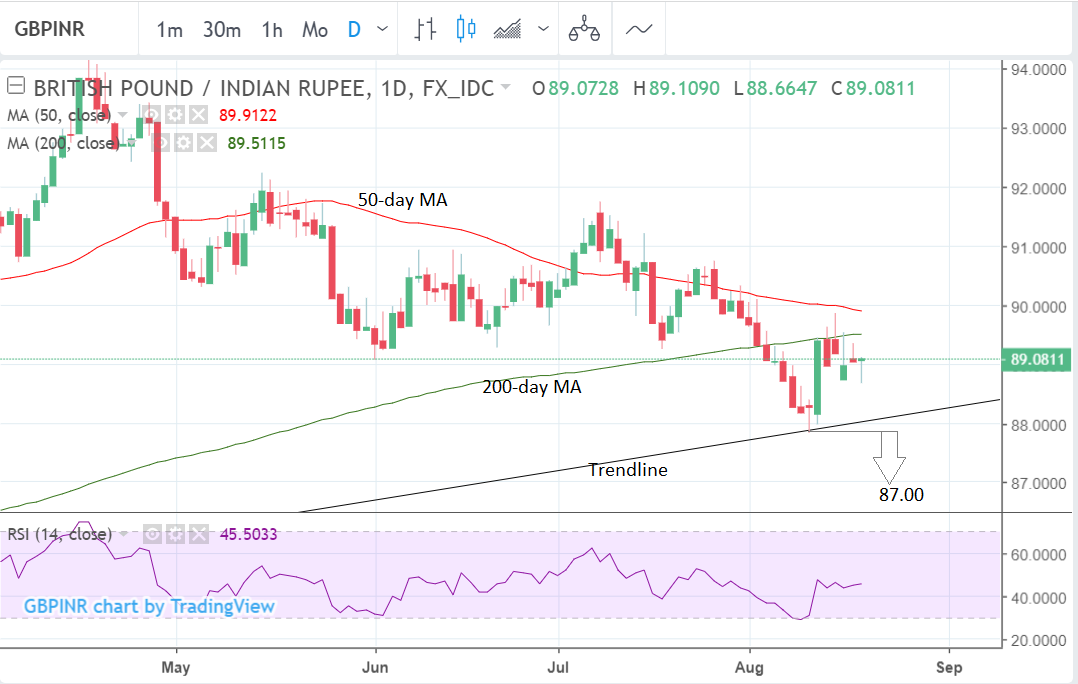Pound-to-Indian-Rupee Rate Week Ahead Forecast: Downtrend Set to Continue
- GBP/INR has fallen to a major trendline support level.
- Pair now poised to break lower, extending the downtrend.
- GBP eyes Bank of England, INR the global market environmnent.

© Adobe Stock
The Pound-to-Rupee rate has fallen from its April highs and recently found support at a major trendline, although this now looks vulnerable to failure.
The exchange rate is also close to the 50 week moving average, which also coincides with trendline support, that helped prop up the market last week.
However, the location of the more significant 200-day moving average directly above the current market level will limit any upside for the pair and leaves it with a downside bias in the short term.

Above: Pound-to-Rupee rate shown at weekly intervals.
Will the trendline hold or break? In the absence of any strong bullish signals or developments, the downtrend remains dominant and is likely to prevail.
A downward break would probably open the door to a move down toward an initial target of 87.00, although deeper losses would also be possible.

Above: Pound-to-Rupee rate shown at daily intervals.
The Pound: What to Watch
The main event for the Pound in the week ahead will be testimony from Bank of England (BOE) governor Mark Carney the Parliamentary Treasury Select Committee, on Wednesday, August 22, covering the inflation and economic outlook.
Although the BOE raised interest rates at the start of August, the chances of a further hike in the short term are generally viewed as low mainly given the increasing uncertainty around Brexit. Carney recently said the chances of a 'no-deal' Brexit were "uncomfortably high" and that this presents a risk to the economy.
The Pound is highly correlated with interest rates because of their influence over foreign capital inflows. Higher rates tend to attract greater inflows of capital, which raises demand for Sterling. Therefore, traders will be analysing Carney's statements for clues on when rates might change again, even if more clarity is unlikely.
The other major release for the Pound is the Confederation of British Industry (CBI) Industrial Trends report for August, with overall activity balance forecast to decline from 11.0 to 10.0 when the report is released on Tuesday, August 21 at 11.00 B.S.T.
CBI surveys are often closely followed by the market due to their timeliness and can provide early insight into activity within the economy.
The Indian Rupee: What to Watch
There are no major Indian economic announcements due this week, which means UK data and global market developments are likely to be the key drivers of the Pound-to-Rupee rate during the days ahead.
The recent bounce in the exchange rate coincided with broad-based Rupee weakness due to instability in emerging markets, which resulted from the sell-off in the Turkish Lira, an ongoing rise in the US Dollar and an escalation of "trade war" tensions between the US and China.
These factors have caused an exodus from risk assets and inflows into safe-havens, which has seen all emerging market currencies under pressure in recent weeks, but especially the Rupee.
The Indian currency shares some key characteristics with Turkey's Lira that make it vulnerable to contagion of emerging market stresses. Chief among these is the rising current account deficit caused by the increasing cost of oil imports.
Rising inflation is another similarity between the two countries but in the case of India, the Reserve Bank of India (RBI) has not been shy about raising interest rates and has already hiked its repo rate by 50 basis points this year to 6.50%. Most analysts expect one more rate rise before the end of 2018, although some say two more are possible.
Given the sensitivity of the Rupee to wider emerging market sentiment, the evolution of the situation in Turkey as well as the China-US trade war will be important determinants of exchange rates in the week ahead.
Advertisement
Get up to 5% more foreign exchange by using a specialist provider to get closer to the real market rate and avoid the gaping spreads charged by your bank when providing currency. Learn more here
